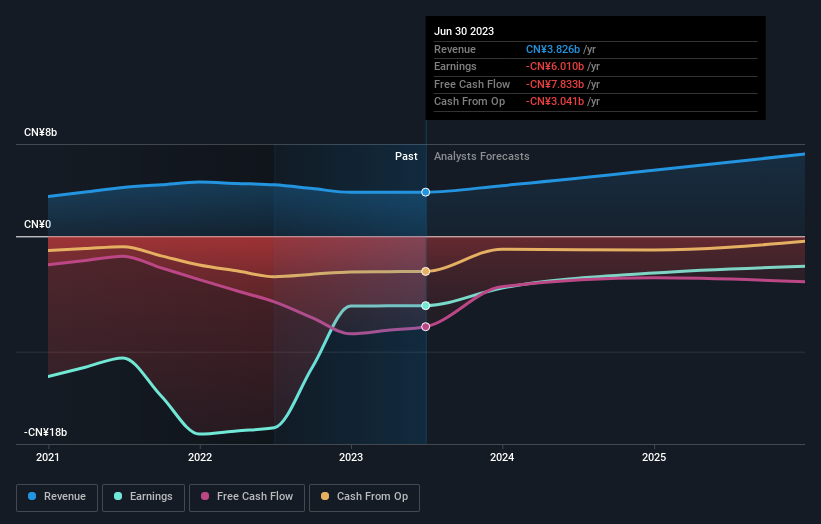Stock Analysis

Key Insights
- Significant control over SenseTime Group by retail investors implies that the general public has more power to influence management and governance-related decisions
- 50% of the business is held by the top 10 shareholders
- Insiders own 23% of SenseTime Group
Every investor in SenseTime Group Inc. (HKG:20) should be aware of the most powerful shareholder groups. With 47% stake, retail investors possess the maximum shares in the company. Put another way, the group faces the maximum upside potential (or downside risk).
And individual insiders on the other hand have a 23% ownership in the company. Large companies usually have institutions as shareholders, and we usually see insiders owning shares in smaller companies.
Let's take a closer look to see what the different types of shareholders can tell us about SenseTime Group.
Check out our latest analysis for SenseTime Group

What Does The Institutional Ownership Tell Us About SenseTime Group?
Many institutions measure their performance against an index that approximates the local market. So they usually pay more attention to companies that are included in major indices.
As you can see, institutional investors have a fair amount of stake in SenseTime Group. This can indicate that the company has a certain degree of credibility in the investment community. However, it is best to be wary of relying on the supposed validation that comes with institutional investors. They too, get it wrong sometimes. If multiple institutions change their view on a stock at the same time, you could see the share price drop fast. It's therefore worth looking at SenseTime Group's earnings history below. Of course, the future is what really matters.

Hedge funds don't have many shares in SenseTime Group. Because actions speak louder than words, we consider it a good sign when insiders own a significant stake in a company. In SenseTime Group's case, its Top Key Executive, Xiao’ou Tang, is the largest shareholder, holding 21% of shares outstanding. In comparison, the second and third largest shareholders hold about 11% and 10% of the stock. Furthermore, CEO Li Xu is the owner of 0.9% of the company's shares.
We did some more digging and found that 10 of the top shareholders account for roughly 50% of the register, implying that along with larger shareholders, there are a few smaller shareholders, thereby balancing out each others interests somewhat.
Researching institutional ownership is a good way to gauge and filter a stock's expected performance. The same can be achieved by studying analyst sentiments. There are plenty of analysts covering the stock, so it might be worth seeing what they are forecasting, too.
Insider Ownership Of SenseTime Group
The definition of an insider can differ slightly between different countries, but members of the board of directors always count. Company management run the business, but the CEO will answer to the board, even if he or she is a member of it.
Insider ownership is positive when it signals leadership are thinking like the true owners of the company. However, high insider ownership can also give immense power to a small group within the company. This can be negative in some circumstances.
Our most recent data indicates that insiders own a reasonable proportion of SenseTime Group Inc.. It is very interesting to see that insiders have a meaningful HK$11b stake in this HK$48b business. Most would say this shows a good degree of alignment with shareholders, especially in a company of this size. You can click here to see if those insiders have been buying or selling.
General Public Ownership
With a 47% ownership, the general public, mostly comprising of individual investors, have some degree of sway over SenseTime Group. While this size of ownership may not be enough to sway a policy decision in their favour, they can still make a collective impact on company policies.
Private Equity Ownership
With a stake of 10%, private equity firms could influence the SenseTime Group board. Some investors might be encouraged by this, since private equity are sometimes able to encourage strategies that help the market see the value in the company. Alternatively, those holders might be exiting the investment after taking it public.
Next Steps:
It's always worth thinking about the different groups who own shares in a company. But to understand SenseTime Group better, we need to consider many other factors. Case in point: We've spotted 1 warning sign for SenseTime Group you should be aware of.
Ultimately the future is most important. You can access this free report on analyst forecasts for the company.
NB: Figures in this article are calculated using data from the last twelve months, which refer to the 12-month period ending on the last date of the month the financial statement is dated. This may not be consistent with full year annual report figures.
Valuation is complex, but we're helping make it simple.
Find out whether SenseTime Group is potentially over or undervalued by checking out our comprehensive analysis, which includes fair value estimates, risks and warnings, dividends, insider transactions and financial health.
View the Free AnalysisHave feedback on this article? Concerned about the content? Get in touch with us directly. Alternatively, email editorial-team (at) simplywallst.com.
This article by Simply Wall St is general in nature. We provide commentary based on historical data and analyst forecasts only using an unbiased methodology and our articles are not intended to be financial advice. It does not constitute a recommendation to buy or sell any stock, and does not take account of your objectives, or your financial situation. We aim to bring you long-term focused analysis driven by fundamental data. Note that our analysis may not factor in the latest price-sensitive company announcements or qualitative material. Simply Wall St has no position in any stocks mentioned.
About SEHK:20
SenseTime Group
SenseTime Group Inc., an investment holding company, engages in developing and selling artificial intelligence software platforms in the People’s Republic of China, Northeast Asia, Southeast Asia, and internationally.
Flawless balance sheet with limited growth.

